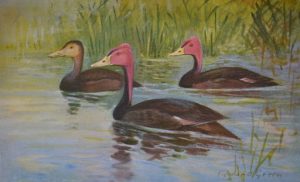Pink-headed Duck
Rhodonessa caryophyllacea
| Class: | Aves |
| Order: | Anseriformes |
| Family: | Anatidae |

LAST SEEN: 1949 IN INDIA
CRITICALLY ENDANGERED
Size – 60 cm.
Physical Description
- Long-necked duck.
- Males have head, sides of neck, and hind neck pale rosy pink; tuft of bright pink on head; throat brown; rest of body mainly glossy dark brown (paler beneath). . Rosy-pinkish bill.
- Females have duller and browner body, pale greyish-pink head and upper neck with brownish wash on crown and hindneck and duller bill.
Distribution and Habitat
- This birds was locally distributed in the wetlands of India, Bangladesh and Myanmar, and occurred rarely in Nepal, with most records from north-east India and adjacent Bangladesh.
- They often inhabited small ponds that were surrounded by bushes and high grass. The surrounding country was usually a plain cut by deep streams. During the colder months they may have moved to rivers.
Reproduction
- The ducks were usually seen on their own or in pairs, and sometimes during the breeding season they aggregated in small flocks of up to ten birds.
- The breeding season of these duck begin in April, female lay spherical eggs, that was either pure white or pale yellow.
- The eggs were and were almost perfectly spherical, unlike the eggs of most other ducks. A clutch consisted of as many as nine eggs and was attended by both the male and female.
Causes for extinction
-
- Clearance of forest and conversion of wetlands for agricultural land has destroyed much of its habitat.
- It is supposed that invasive alien species water hyacinth Eichhornia crassipesmay have contributed to its decline by altering wetland habitats.
- During the late 19th and early 20th centuries, when hunting levels in India were high, hunting pressure and egg collection is also supposed to be the reasons for their decline.
